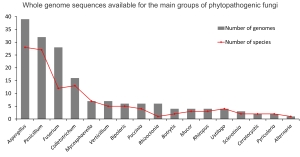Doutorando: Samuel Alves dos Santos (31/10/2017, às 16:00 horas). Since its consolidation as a DNA barcode for Fungi, the ITS sequence has been used widely in comparative molecular studies into the Fungi kingdom. The ITS region is a powerful tool and works very well in taxonomic delimitation in most fungal species, however, there is an intraspecific variation on ITS sequence for a few groups, mainly the ones closely related to fungal species such as Ceratocystis spp.. Four new species of Ceratocystis described based on ITS sequence, when reevaluated using multilocus analysis and crossing between isolates, were concluded to be genotypes from Ceratocystis fimbriata. Inspite of the use of multilocus analysis have being initiated, studies continue to use only ITS sequence for the delimitation of important groups. What would be the possible factors that make the use of new loci difficult? Would it be the cost? Primers availability? The Effective cost to evaluate one locus more, since the purchase of new primers until sequencing, is about US$ 22.00 per sample. That is a relatively low cost to study and describe a new species, since it does not require a large number of samples. The advance in sequencing and bioinformatics tools, coupled with the “1000 Fungal Genomes Project” of JGI initiative in partnership with international researchers, contributes to the exponential rise in the number of whole genomes available for Fungi each year. Currently, EnsemblFungi platform has 811 genomes from 523 species. Among these species, basically all the main groups of phytopathogenic fungi are represented, such as Aspergillus, Penicillium, Fusarium and Colletotrichum with more than 15 genomes of at least 10 different species each. It is also noteworthy for Mycosphaerella, Verticillium, Bipolaris, Puccinia, Rhizoctonia and Botrytis with more than five genomes each. Fungal with sequencing in progress also may be check on MycoCosm platform. This data represents a great potential to get new primers and try to amplify another loci to be used additionally to the ITS sequence on comparative molecular studies in fungi, mainly for closely related species.
Orientador: Acelino Couto Alfenas
Data e hora: 31/10/2017 às 16:00 horas
Local: Auditório do ESB

